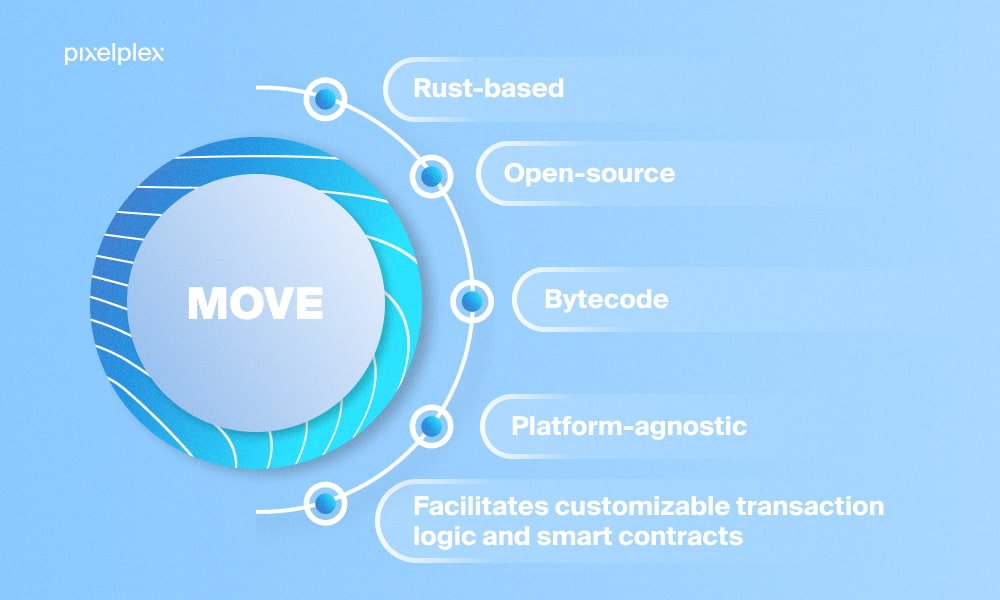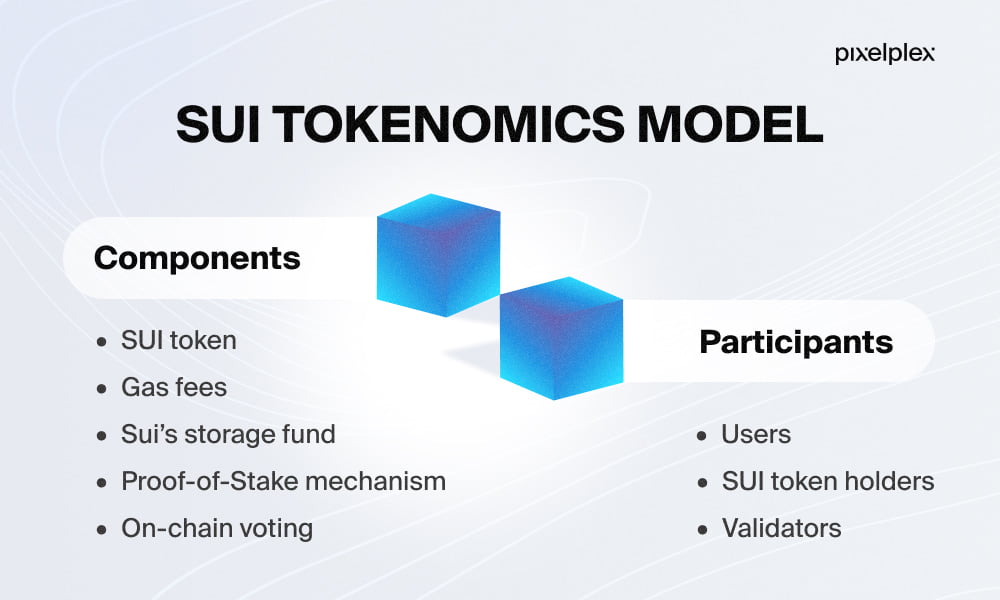
A new member of the distributed ledger team has entered the blockchain universe. The Sui blockchain seems to have some interesting features that could make it stand out in the market. But how far can it go?
The blockchain market is projected to grow to $67 billion by 2026 as interest in the technology remains high despite the rapid changes occurring in the Web3 space. This has led to the development of numerous cutting-edge new platforms, Sui included.
But what makes this innovator unique, and what does it hope to accomplish?
What are the potential benefits of the Sui blockchain? Read on to learn more about its design, key features, and tokenomics model.
What is the Sui blockchain?
Sui blockchain is a permissionless, Proof-of-Stake (PoS) powered, Layer 1 blockchain that aims to enable a wide variety of next-generation latency-sensitive decentralized applications as well as instant settlement and high throughput.
Mysten Labs, an R&D firm established by ex-executives of Meta’s Novi Research and the primary architects of the Diem blockchain and the Move programming language, created the Sui blockchain. The company intends to revolutionize the Web3 landscape by developing cutting-edge solutions that will appeal to innovators from all walks of life.
Successfully raising $300 million in Series B funding puts Mysten Labs in a strong position to continue growing.
Mysten Co-Founder and CEO Evan Cheng had this to say about the company’s first blockchain platform, Sui:
“Current Web3 infrastructure is in the dial-up era — it’s slow, expensive, capacity constrained, insecure, and simply hard to build for. With Sui, we are endeavoring to build a blockchain that scales with demand and incentivizes growth, eliminating middlemen, and enabling users across applications to seamlessly integrate and interact with their favorite products.”
What is Sui’s architecture?
The blockchain has three main parts, as detailed in Sui’s technical documentation:
- Objects. There are programmable objects in Sui’s possession that were created and are managed by smart contracts that are enabled by the Move platform. All of Sui’s objects can be broken down further into two types: those with changeable data values and those with immutable packages.
- Transactions. The term “transaction” is used to describe any update or alteration made to the Sui ledger.
- Validators. Each node in the Sui network is managed by a separate group of validators. They each use their own copy of the Sui software on their own computer.
The Sui Consensus Engine, made up of Narwhal and either Bullshark or Tusk, is another interesting component.
Data presented to consensus must be made available, and that’s Narwhal’s job.
To reach a consensus on the proper order of this information, you can use Bullshark or Tusk.
What is the Sui Explorer?
The Sui Explorer, an exclusive tool for users and developers eager to begin creating on Sui, will be released that year in August. These are some of its primary objectives:
- Maintain an accurate database of on-chain information, actions, and metrics
- Facilitate the checking and monitoring of all assets and agreements
- Help thoroughly with testing and inspection
- Bring innovative features to Move and make smart contract development easier.
What language is Sui Created on?

Move, an open-source programming language built on top of Rust, is the language behind the Sui blockchain.
Move is an extensible bytecode language for building smart contracts and transaction logic. It’s platform-independent in the sense that it allows developers working on different blockchains to share code and resources.
The goal of Move is to make the jump from Web2 to Web3 simpler and safer for users. It is also regarded as robust when dealing with poison tokens, re-entrancy vulnerabilities, and spoofed token approvals.
The scalability of the blockchain is ensured by the fact that Move’s type system and data model are compatible with Sui’s parallel agreement. According to a whitepaper published on March 19, 2022, it was stated that a single-worker Sui validator running on an 8-core M1 MacBook Pro could process 120,000 token transfers per second without optimization (TPS).
How does the Sui blockchain work, and what are its advantages?
Parallel transaction execution, a streamlined developer experience, a novel approach to security, and improved user experience for Web3 solutions are just a few of the unique technical features that developers say come standard with Sui.
Parallel transaction execution
Byzantine Consistent Broadcast allows Sui to avoid consensus and parallelize the execution of many independent transactions, thereby reducing latency and increasing throughput.
Additionally, while many other blockchains group transactions into conventional blocks, each transaction in Sui is validated independently. Upon completion, each transaction is issued a certificate of finality that cannot be revoked under any circumstances.
Simplified developer experience
Sui’s Move is a programming language designed to make working with blockchains simpler for programmers. It is hoped that this will result in less repetitive coding and fewer mistakes with fundamental ideas.
The blockchain also allows Sui developers to efficiently implement dynamic NFTs that can be upgraded and/or grouped for use in specialized applications. This aids the development of more nuanced in-game economies and leads to more satisfying results in terms of player feed-back.
Unique security approach
Sui, unlike many other blockchains, does not prioritize network synchrony to the same extent. Therefore, the platform is able to preserve its security characteristics despite experiencing unfavorable network conditions and circumstances, such as network splits or DoS attacks.
Superior Web3 applications and refined user experience
The creators of Sui claim that the wealth of high-quality tools provided by the Sui Development Kit will allow engineers to create first-rate UX in the Web3 space (SDK).
In particular, the blockchain has the potential to simplify the creation of:
- Financial (TradFi) and DeFi (Digital Finance) basics on the blockchain
- Programs designed to reward repeat customers and encourage brand loyalty
- Games and business logic that are complex
- Provision of services for the tokenization of assets
- Online social networks that don’t rely on a single authority
- A greater number of useful, modifiable NFTs
Sui blockchain Tokenomics Model

Users, SUI token holders, and validators make up the three main pillars of the Sui blockchain tokenomics model.
- To build, alter, and exchange digital assets or to interact with more complex programs dependent on smart contracts, users send transactions to the Sui platform.
- Members of the Proof-of-Stake mechanism can participate by delegating their SUI tokens to validators. They are welcome to take part in the administration of Sui.
- On the Sui platform, transactions are processed and carried out by validators.
What are the key components of the Sui economy?
There are five main parts to the Sui tokenomics framework. In this case, we’re talking about the SUI token, gas prices, Sui’s storage fund, the Proof-of-Stake protocol, and on-chain voting.
SUI token
The SUI token is the native asset of the Sui blockchain. There will never be more than 10 billion SUI tokens issued.
There are four uses for SUI:
- This token can be staked to take part in the PoS consensus.
- It’s the currency of choice for covering the costs of driving around for business and other purposes.
- It’s considered a liquid asset that supports the Sui blockchain economy as a whole.
- It entitles the bearer to vote in on-chain elections.
In addition, the blockchain provides the Sui Wallet, a Google Chrome extension that can be used to store and manage Sui tokens. Using the wallet, users can control where their funds are sent and received on the network and generate new addresses.
Gas fees
All actions performed on the Sui network incur Gas fees. Users can pay separate fees for execution and storage, which is a great feature of Sui’s gas mechanism. It’s convenient for users, and they can use the reference price as a safe point of reference for their transactions.
Sui’s storage fund
It is the job of Sui’s storage fund to compensate future validators for the costs of storing data on the blockchain and to redistribute stake rewards over the lifespan of the network. With the platform’s careful planning, the storage fund can operate reliably and without risk of ever being depleted.
The Proof-of-Stake mechanism
The PoS consensus mechanism is used by validators and SUI delegates to select and interact with users and incentivize them to behave honestly.
For the duration of an epoch, a group of validators who have been granted a certain amount of SUI stake handles all operations. If SUI delegation is used, tokens are locked for the duration of the epoch and cannot be retrieved until the epoch ends and validators agree on all transactions that occurred during the epoch.
In particular, when the epoch changes, SUI token holders can destake their tokens and select a new delegate validator.
On-chain voting
SUI token holders have a voice in Sui’s governance and protocol upgrades via on-chain voting. The Sui team has indicated that it intends to issue additional information on protocol governance soon.
What are the downsides of Sui?
Sui, like all other blockchains, has its own set of compromises due to its engineering.
- To begin, while most other blockchains only need a single consensus protocol implemented, Sui needs to implement both Byzantine Consistent Broadcast for handling simple transactions and a consensus protocol for handling transactions involving shared objects. As a result, Sui developers are obliged to keep a considerably larger codebase.
- Second, the sender is limited to submitting a single transaction at a time because Sui sacrifices consensus for a large number of transactions in order to facilitate multi-lane processing and get rid of head-of-line blocking.
- Third, because Move, Sui’s proprietary programming language, is still in its infancy, there are currently only a small number of experienced Move developers who can contribute to the growth and improvement of the Sui ecosystem.
Once Sui becomes more popular, however, these and other problems will likely be solved. For the time being, the benefits of the blockchain’s efficiency and usability seem likely to outweigh the complexities.
Is it possible for Sui to significantly alter the market, and if so, should you put money into it?

Since Sui is relatively new, its full potential has not yet been shown. If it wants to ride the blockchain protocol wave, it will also have to compete with Ethereum, Solana, Flow, and others.
Due to its novelty and limited user base, the Sui blockchain is only known to support a handful of projects so far, the most notable of which are SoWork and Lucky Kat Studios.
SoWork
SoWork is an up-and-coming company in the coworking space that plans to create a digital version of the traditional office. To facilitate the rapid and low-cost minting of composable, mutable NFTs for its clientele, it has settled on Sui as the underlying blockchain platform.
The two Sui features that SoWork plans to roll out soon are:
- Results-Based Compensation Corporations will be able to offer employees NFTs with unlockable perks based on their own unique parameters. These non-cash incentives (NFTs) can be paid out based on performance, value, or an event. Members of the same team can facilitate teamwork by presenting NFTs to each other.
- Using Mapmaker’s NFT minting features, designers can make unique and customizable NFTs (like clothes or furniture) and upload them to their virtual world.
Lucky Kat Studios
Lucky Kat Studios, based in the Netherlands, aims to develop innovative and polished mobile games. In order to add more premium features to its PanzerDogs NFT gaming project, the company has decided to adopt the Sui blockchain.
The company has chosen Sui because it considers the blockchain’s programming model to be a natural fit for decentralized gaming and a necessary condition for the efficient management of in-game assets.
Sui’s primary design feature is on-chain data storage, which enables in-game customizations and upgrades to be delivered straight to players without the need for any intermediary servers. As a result, Sui is an ideal chain for supporting games like PanzerDogs, where NFTs and gameplay are intrinsically intertwined.
SUMMARY ABOUT SUI BLOCKCHAIN
In terms of technical features, development philosophy, and goals, the Sui blockchain seems to have struck a chord with a sizable subset of blockchain believers.
If Sui wants to see widespread adoption, it will have to face off against formidable competition from other blockchains and maintain a consistently superior ecosystem.
Get in touch with our team of expert blockchain developers and consultants whether you plan to use Sui or another blockchain platform as the foundation for your blockchain project.
Leave a Reply